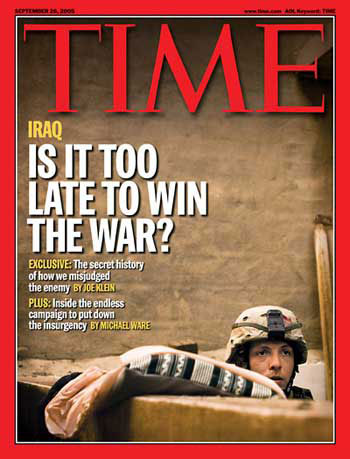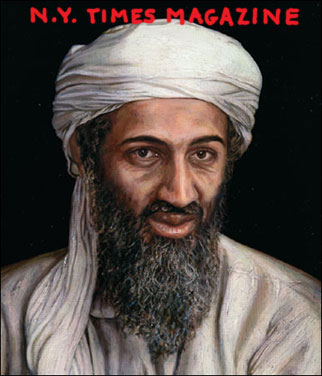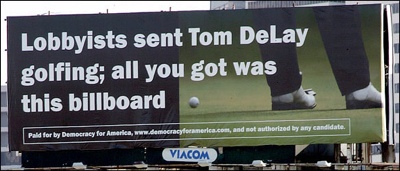Notes
This Year's Fallujah

With Katrina having drowned out most other news in September, I thought it was worth taking a look back at two iconic images.
The TIME cover is from September 26th issue, but the photo itself was taken on or around September 2nd, during a military offensive in Tall ‘Afar. The second image is a painting that appeared on the cover of the September 11th (anniversary) issue of the NYT Magazine. (Lacking a copy of the actual cover, I added the publication title with my own lettering.)
The TIME cover was shot during a military operation in which TIME reporters were along for the ride. If you read the cover story, three significant points are made:
1. According to TIME, the attack on Tall ‘Afar was "this year’s Fallujah."
The magazine states that the assault involved "7,000 U.S. and Iraqi
soldiers and hundreds of Bradleys, battle tanks, artillery pieces, all
combined with AC-130 Spectre gunships, F-16 fighter jets and attack
helicopters."
2. This operation was "mostly unseen, with accounts of the
fighting limited largely to the reports of U.S. and Iraqi officials in
Baghdad."
3. Whether a four day pause ordered by President al-Jafaari had
anything to do with it, the operation didn’t round up many insurgents
and was ultimately characterized as "whacking at moles."

The painting on the NYT Magazine illustrates the cover story
by Mark Danner about the way Osama bin Laden essentially got the better
of George Bush and the neocons. Danner’s thesis is that bin Laden
outsmarted us, luring the U.S. into a campaign in Iraq that would
ultimately undermine America’s "all or nothing" proposal of winning
over the Middle East to democracy. Along the way, he argues that al
Qaeda turned itself from an organization into an ideology characterized
by an opposition to U.S. interventionism and American support for
authoritarian Arab regimes.
My sense is that September was a turning point. The Tall ‘Afar
photo (with the small, young soldier’s face dipping down and blocked by
an unfamilar garment, pillow or blanket) speaks to the shrinking
viability of the American military in Iraq, and how our role has become
progressively obscured by the greater political, cultural, religious
and physical landscape.
Representing bin Laden in this visual vocabulary also seems
like a definitive gesture. I can’t wait to see how BAG readers break it
down. However, you don’t get memorialized with this kind of portraiture
if your legacy remains incomplete. The Administration may want to
ignore OBL’s existence, but the fact is, bin Laden is the one who has
most framed Bush’s presidency, and so far (perverse as it may be), is
far ahead in terms of effect.
(image 1: Benjamin Lowy/Corbis. September
26, 2005. Tall ‘Afar, Iraq. Time Magazine. Cover. image 2: Painting of
Osama bin Laden by Brenda Zlamany. September 11, 2005. New York Times
Magazine. Cover.)


Reactions
Comments Powered by Disqus